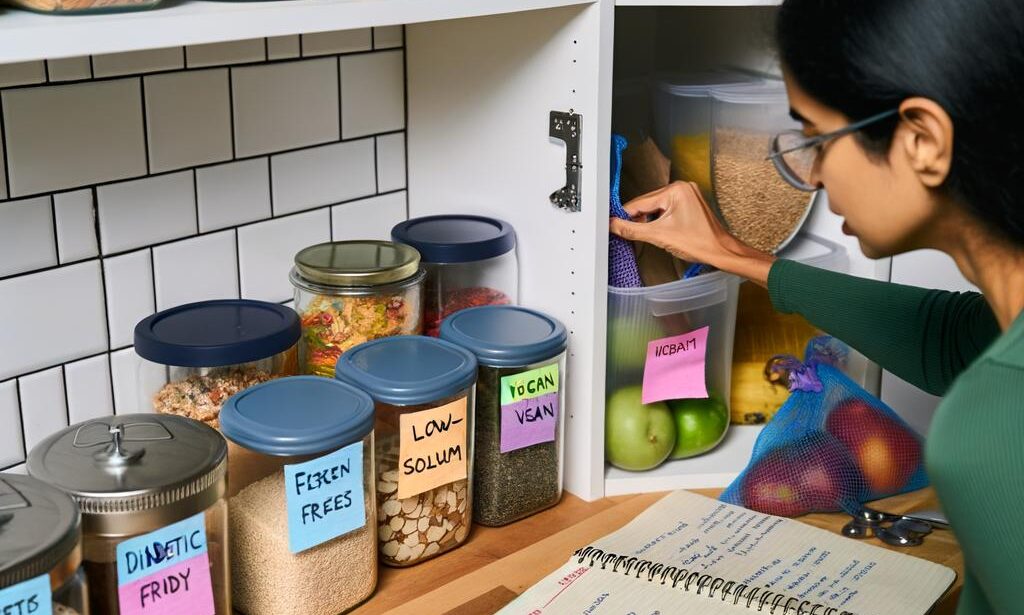Navigating the complexities of special diets requires not only an understanding of nutritional needs but also a strategic approach to food storage. Whether due to allergies, intolerances, medical conditions, or personal choices, managing a special diet involves careful planning to ensure that the right foods are available when needed. In this article, “Managing Special Diet Food Storage: Tips & Tricks,” we delve into the practical aspects of organizing and maintaining a kitchen that caters to specific dietary requirements.
From the importance of avoiding cross-contamination to the art of maximizing shelf life, we will provide you with a comprehensive guide to help streamline your food storage processes. Our aim is to equip you with the knowledge and skills necessary to create an efficient and safe environment for managing your special diet. Whether you’re dealing with gluten-free, keto, vegan, or any other specialized eating plan, our tips and tricks will assist you in keeping your pantry and refrigerator in top shape, ensuring that your dietary needs are met with ease and confidence. Join us as we explore the best practices for special diet food storage that can simplify your daily routine and support your health goals.
Table of Contents
- Managing Special Diet Food Storage: Tips & Tricks
- Understanding Special Diet Food Storage Needs
- Organizing Your Special Diet Food Storage Space
- Tips for Extending the Shelf Life of Special Diet Foods
- Incorporating Special Diet Foods into Your Meal Planning
- Q&A
- The Conclusion

Managing Special Diet Food Storage: Tips & Tricks
When it comes to managing special diet food storage, there are a few tips and tricks that can make the process easier and more efficient. Whether you’re following a gluten-free, dairy-free, or other special diet, proper food storage is essential for maintaining the quality and safety of your food. Here are some helpful tips to help you manage your special diet food storage:
- Label Everything: Clearly label all of your special diet foods with the date of purchase and expiration, as well as any specific dietary information.
- Use Airtight Containers: Store your special diet foods in airtight containers to help maintain freshness and prevent cross-contamination.
- Organize by Category: Keep your special diet foods organized by category (e.g. grains, proteins, snacks) to make meal planning and preparation easier.
Additionally, consider creating a designated area in your pantry or refrigerator specifically for your special diet foods. This will help you easily locate what you need and avoid any mix-ups with non-diet-friendly items. By following these tips and tricks, you can effectively manage your special diet food storage and ensure that your dietary needs are met.

Understanding Special Diet Food Storage Needs
When it comes to managing special diet food storage, there are a few key tips and tricks to keep in mind. Whether you’re following a gluten-free, dairy-free, or other special diet, proper storage is essential for maintaining the quality and safety of your food. Here are some helpful guidelines to ensure that your special diet foods stay fresh and delicious.
First and foremost, it’s important to properly label all of your special diet foods. This will help you easily identify them in your pantry, refrigerator, or freezer, and prevent any mix-ups with non-special diet items. Use bold, clear labels that specify the type of special diet (e.g. “gluten-free,” “dairy-free,” ”vegan”) and the expiration date, if applicable. Additionally, consider using color-coded labels or stickers to further differentiate your special diet foods from the rest of your kitchen staples.
Another important consideration for special diet food storage is the use of airtight containers. Whether you’re storing dry goods, leftovers, or pre-prepared meals, using airtight containers can help prevent cross-contamination and maintain the freshness of your food. Look for containers that are specifically designed for special diet foods, such as gluten-free storage bags or dairy-free meal prep containers. These containers are often made of high-quality, food-safe materials and may feature special seals or locking mechanisms to keep your food secure.

Organizing Your Special Diet Food Storage Space
When it comes to managing a special diet food storage space, organization is key. Whether you’re following a gluten-free, dairy-free, or any other type of special diet, having a well-organized storage space can make meal prep and cooking much easier. Here are some tips and tricks for :
- Label Everything: Use clear, easy-to-read labels to identify different types of special diet foods. This will make it easier to find what you need when you’re cooking or meal prepping.
- Use Storage Containers: Invest in a variety of storage containers to keep your special diet foods organized. Look for containers that are airtight and stackable to maximize space in your storage area.
- Create a Meal Plan: Plan out your meals for the week and organize your special diet foods accordingly. This will help you know exactly what you need and where to find it when it’s time to cook.
By following these tips and tricks, you can create a well-organized special diet food storage space that makes meal prep and cooking a breeze.

Tips for Extending the Shelf Life of Special Diet Foods
When it comes to managing special diet food storage, it’s important to take extra care to extend the shelf life of these items. Whether you’re following a gluten-free, dairy-free, or other special diet, here are some tips and tricks to help you keep your food fresh for longer.
First, make sure to properly label and organize your special diet foods in the fridge, freezer, and pantry. This will help you keep track of expiration dates and ensure that you use up items before they go bad. Additionally, consider investing in airtight containers or resealable bags to help maintain the freshness of your special diet foods. Finally, be mindful of temperature and humidity levels in your storage areas, as these can impact the shelf life of your items.
Here are a few more :
- Rotate your stock: Use older items before newer ones to prevent food waste.
- Store items properly: Follow recommended storage guidelines for each type of special diet food.
- Check for spoilage: Regularly inspect your special diet foods for any signs of spoilage or expiration.

Incorporating Special Diet Foods into Your Meal Planning
When it comes to managing special diet food storage, there are a few tips and tricks that can help make the process easier and more efficient. Whether you follow a gluten-free, dairy-free, or vegan diet, can be a seamless experience with the right strategies in place.
One way to effectively manage special diet food storage is to designate specific areas in your kitchen for these items. This can help you stay organized and ensure that you always have the ingredients you need on hand. Consider using clear storage containers or labels to easily identify different types of special diet foods. Additionally, keeping a running inventory of these items can help you stay on top of what you have and what you need to restock.
Another helpful tip is to plan your meals in advance and create a shopping list based on your special diet requirements. This can help you avoid last-minute trips to the grocery store and ensure that you have everything you need to prepare your meals. When storing special diet foods, be mindful of their shelf life and expiration dates to prevent food waste. By following these tips and tricks, you can effectively manage special diet food storage and seamlessly incorporate these items into your meal planning.
| Designate specific areas for special diet foods | Use clear storage containers or labels |
| Create a meal plan and shopping list | Keep track of expiration dates |
Q&A
Q: Why is it important to properly manage special diet food storage?
A: Properly managing special diet food storage is important to ensure that the food remains safe to eat and maintains its nutritional value. It also helps to prevent cross-contamination with non-diet foods.
Q: What are some tips for organizing special diet food storage?
A: Some tips for organizing special diet food storage include labeling all containers with the date of purchase and expiration, using a separate area of the pantry or refrigerator for special diet foods, and keeping a list of inventory to track what needs to be used first.
Q: How can one prevent cross-contamination in special diet food storage?
A: To prevent cross-contamination, it is important to use separate utensils and cooking equipment for special diet foods, store them in sealed containers, and clean surfaces and hands thoroughly before handling special diet foods.
Q: What are some tricks for maximizing the shelf life of special diet foods?
A: Tricks for maximizing the shelf life of special diet foods include storing them in airtight containers, using vacuum-sealed bags for freezing, and rotating the stock to use the oldest items first.
Q: How can one effectively manage a special diet food storage system in a shared household?
A: In a shared household, it is important to communicate with other members about the importance of maintaining the special diet food storage system. It may also be helpful to designate specific shelves or areas for special diet foods and non-diet foods.
The Conclusion
In conclusion, managing special diet food storage can be a challenging task, but with the right tips and tricks, it can become much more manageable. By organizing your pantry, labeling your food items, and utilizing proper storage containers, you can ensure that your special diet foods stay fresh and easily accessible. Additionally, staying informed about expiration dates and rotating your stock regularly will help to minimize waste and ensure that you always have the right foods on hand. With these strategies in place, you can take control of your special diet food storage and make meal planning and preparation a much smoother process.

